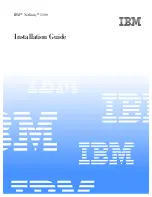
This soft copy for use by IBM employees only.
carry out this task. The underlying reason behind this is that PSSP 2.1 uses a
product called the Network Installation Manager (NIM) to carry out many of the
tasks associated with the installation of the nodes. NIM is not compatible with
AIX Version 3.2.5.
While creating partitions with different versions of AIX, be extremely careful
when rebooting the nodes after applying the System Partitioning, and ensure that
the desired action has taken place. If the node should network install, then
check that this has actually happened. Similarly, if the node should be rebooting
from disk to the same version of AIX, then ensure this also actually happened. If
any discrepancies are found, then attempt to rectify the situation immediately.
5.1.3 Some Limitations of System Partitioning
Before beginning System Partitioning, it is a good idea to assess whether the
following limitations will have an effect on the configurations that can be applied:
•
Shared hard disk drives must be connected to nodes in the same partition.
•
HACMP (Highly Available Clustered Multi Processors) nodes must be in the
same partition.
•
Virtual Shared Disks (VSDs) cannot span partitions.
If there are different versions of AIX in the partitions, then it is obvious to see
how the issue of compatibility of code makes these limitations essential. Even
when all the partitions are running the same versions of code, there is still good
justification for these limitations.
Typically, System Partitioning is set up to logically separate applications (for
example, to separate applications or company departments). In these instances,
there would be little sense in having a node take over the resources of another
node in a different partition using HACMP.
Similarly, there would be little point in spreading a database across two
partitions using VSDs, when the partitions service completely different
departments that do not use the same database tables. If these two
departments did use the same database tables, then the database must reside
within one partition when using VSDs.
5.2 Partitioning and the High Performance Switch
The High Performance Switch is central to the configuration of System
Partitioning. Even in systems that do not have a High Performance Switch
installed, the configuration is still based on the assumption that a switch is
installed in each frame. In other words, similar sets of rules apply to configuring
the System Partitioning, regardless of whether a High Performance Switch is
installed or not. In fact, the only difference is for systems that have a High
Performance Switch that services nodes in more than one frame, but this issue
will be addressed in more detail later in this chapter.
Chapter 5. System Partitioning
127
Summary of Contents for RS/6000 SP
Page 2: ......
Page 14: ...This soft copy for use by IBM employees only xii SP PD Guide...
Page 16: ...This soft copy for use by IBM employees only xiv SP PD Guide...
Page 106: ...This soft copy for use by IBM employees only 86 SP PD Guide...
Page 178: ...This soft copy for use by IBM employees only 158 SP PD Guide...
Page 214: ...This soft copy for use by IBM employees only 194 SP PD Guide...
Page 248: ...This soft copy for use by IBM employees only 228 SP PD Guide...
Page 290: ...This soft copy for use by IBM employees only 270 SP PD Guide...
Page 292: ...This soft copy for use by IBM employees only 272 SP PD Guide...
Page 300: ...This soft copy for use by IBM employees only 280 SP PD Guide...
Page 304: ...This soft copy for use by IBM employees only 284 SP PD Guide...
Page 308: ...This soft copy for use by IBM employees only 288 SP PD Guide...
Page 310: ...This soft copy for use by IBM employees only 290 SP PD Guide...
Page 316: ...IBML This soft copy for use by IBM employees only Printed in U S A SG24 4778 00...















































